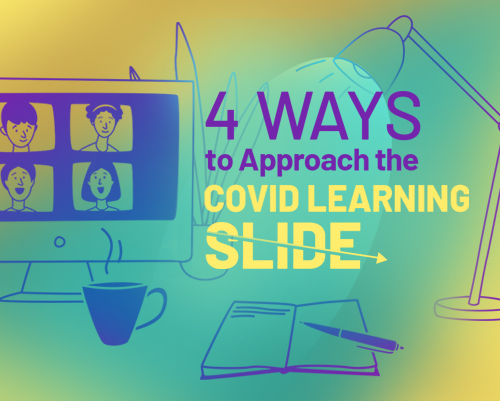
Educators have long battled the “summer slide,” which refers to the loss of learning that takes place when students are out of school for the summer. Now in our pandemified world, there’s a whole new learning challenge to overcome: the COVID slide.
A recent McKinsey & Co. study found that students started school last fall roughly three months behind in mathematics. For students of color, this number increases to as much as five months behind—almost as if no learning whatsoever had taken place once the pandemic struck.
Reading levels are slightly better, with students averaging just a month and a half behind. But it’s not a rosy picture, and it may get worse before it gets better. Despite the incredible innovation and commitment with which educators met this unprecedented disruption, the American educational system was simply not designed for extended periods of remote learning. And concerns are growing about the pandemic’s long-term effects on education.

While the worst-case scenarios from the spring may have been averted, the cumulative learning loss could be substantial, especially in mathematics—with students on average likely to lose five to nine months of learning by the end of this school year. Students of color could be six to 12 months behind, compared with four to eight months for white students. While all students are suffering, those who came into the pandemic with the fewest academic opportunities are on track to exit with the greatest learning loss. (McKinsey & Co.)
What can we do to alleviate these setbacks in students’ learning? There will be many instructional methods and innovations to address the academic losses, but I want to offer a few thoughts on our big-picture approach.
- Meet kids where they’re at, not where they should be. It’s hard not to let our frustration with the situation bleed into our connection with students, but it’s critical. None of this is their fault or ours; we are all in this together. Where they are is where they are, and we take our cue from that and move forward. Any progress is progress and should be celebrated and built upon. Where do we go from here? Wherever “forward” looks like. And it may be different for each individual student.
- Remember how resilient young people truly are. Young people these days have overcome so much already, and they will continue to do so. They have the ability to bounce back from setbacks much faster than we might think. When things return to “normal” (or as normal as they will ever be), we will see just how elastic and retentive they can be. With educators committed to seeing them succeed, these students have every chance of not just catching up, but exceeding all expectations.
- Consider lessons learned beyond the academic. Young people haven’t stopped learning this year—it’s just that the lessons have gone beyond the academic. They have been watching the role models in their lives—parents, educators, and others—deal with unprecedented difficulties. Even if their academic performance is temporarily in abeyance, they are learning life skills about perseverance, creative problem solving, adjusting to circumstances we would not choose, and more. These lessons will serve them the rest of their lives—and may help them approach their academic learning with more maturity when regular in-class instruction can resume.
- Don’t forget the difference you are making. The impact you have is often invisible on a day-to-day basis. The rewards are cumulative and may not be clearly evident immediately. But never forget that you are making a difference. Your consistent presence in kids’ lives—in person or via a screen—means more than you may ever know.
Next week at markcperna.com, I’ll be looking at the COVID slide through the lens of the Light at the End of the Tunnel strategy. We can inspire young people to overcome the academic setbacks they’ve experienced in 2020 and come back stronger—motivated by a clear Light at the end of their educational Tunnel.
